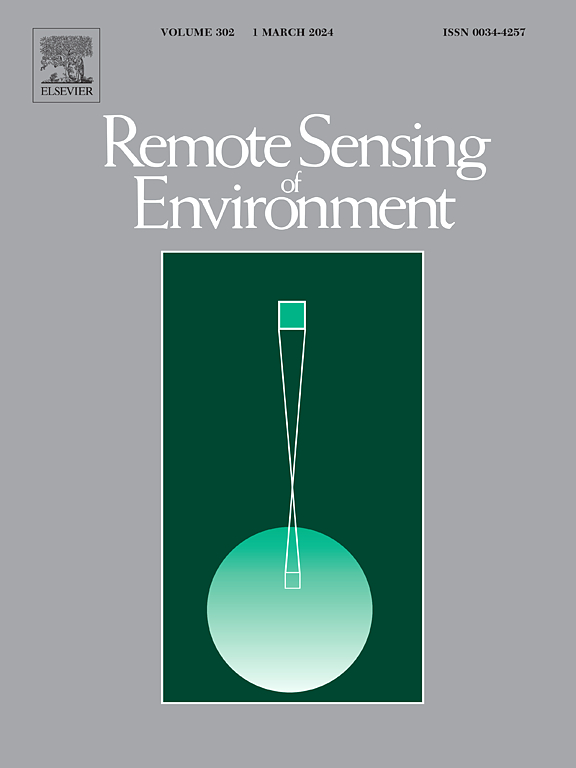Linking Kubelka-Munk and recollision probability theories for radiative transfer simulations in turbid canopy
IF 11.1
1区 地球科学
Q1 ENVIRONMENTAL SCIENCES
引用次数: 0
Abstract
Radiative transfer (RT) theories formulate vegetation radiative transfer models (RTMs) that link the biophysical properties of vegetation with remote sensing signals. Compared to classical RT theories, the recollision probability theory (also known as p-theory) is distinctive as it predicts some optical properties of vegetation canopies using fewer spectral invariants and simpler mathematical functions. This theory commonly employs an effective recollision probability () that is assumed to spectrally independent for vegetation-photon interactions, to describe the absorptive and reflective properties of a vegetation canopy at any wavelength. Most p-theory studies approximate using the canopy-average recollision probability at different locations within the canopy, enabling its estimation based on canopy structural properties. However, the canopy-average recollision probability and different meanings. As an effective parameter, should be obtained by fitting the p-theory formulations, as done in previous studies using simulated and measured canopy optical properties for specific canopies. These studies have empirically shown that generally increases with canopy leaf area and exhibits some spectral variability. Building on this empirical evidence, we explore an analytical expression for and its dependence on leaf optical and canopy structural properties.
In this study, we link the recollision probability theory with the classical Kubelka-Munk (KM) theory, a two-stream RT theory which predicts canopy optical properties by solving the corresponding differential equations. By using the KM theory as applied in the SAIL model, we derive the analytical expression for the absorptance of vegetation canopies illuminated by diffuse radiation. This absorptance is then used to derive based on its relationship with absorptance in the p-theory. In this way, we express as a function of leaf albedo () and canopy leaf area index (LAI, ). Our findings demonstrate that, for a given canopy, could be approximated as a function of LAI () by using Taylor series expansion. This approximation aligns with Stenberg's, 2007 canopy-average recollision probability, although the two have different meanings and are derived using different approaches. More importantly, we demonstrate that increases with leaf albedo and that the difference between the LAI-based and true spectrally-dependent scales with , reaching up to 0.15. Consequently, the use of LAI-based in the p-theory could lead to some errors in simulating canopy absorptive and reflective properties. This study bridges two widely used RT theories and presents an estimation of . We provide an analytical expression for spectrally-dependent for turbid canopies, and mathematically demonstrate how it can be approximated by spectrally-independent . These findings clarify the rationale and limitations of assuming spectral invariance in the p-theory.
求助全文
约1分钟内获得全文
求助全文
来源期刊

Remote Sensing of Environment
环境科学-成像科学与照相技术
CiteScore
25.10
自引率
8.90%
发文量
455
审稿时长
53 days
期刊介绍:
Remote Sensing of Environment (RSE) serves the Earth observation community by disseminating results on the theory, science, applications, and technology that contribute to advancing the field of remote sensing. With a thoroughly interdisciplinary approach, RSE encompasses terrestrial, oceanic, and atmospheric sensing.
The journal emphasizes biophysical and quantitative approaches to remote sensing at local to global scales, covering a diverse range of applications and techniques.
RSE serves as a vital platform for the exchange of knowledge and advancements in the dynamic field of remote sensing.
 求助内容:
求助内容: 应助结果提醒方式:
应助结果提醒方式:


